Tour de France
![]()
This article describes the cycling event. For the current edition, see Tour de France 2021. For other meanings, see Tour de France (disambiguation).
The Tour de France [ˌtuʀdəˈfʀɑ̃ːs], also known as the Grande Boucle [gʀɑ̃dˈbukl] (French for Great Loop), is the most famous and arguably the most important road cycling race in the world. It is one of the Grand Tours, along with the Giro d'Italia and the Vuelta a España.
Since 1903, the Tour de France has been held every year in July, with varying routes across France and nearby countries. During the First World War the race was cancelled from 1915 to 1918, the Second World War caused an interruption from 1940 to 1946. Since 1992 the Amaury Sport Organisation (ASO) is the organizer of the stage race.
The Tour de France is considered by many to be the third largest sporting event in the world after the Olympics and the World Cup, and the largest annual sporting event. It is often described as the most difficult of the three major national tours.
A women's Tour de France, or Grande Boucle Féminine, was held intermittently from 1984 to 2009. Its length and importance were small compared to the men's Tour. Since 2014, the ASO has organised La Course by Le Tour de France, initially as a circuit race on the Champs-Elysees on the day of the final stage of the 2014 Tour de France.

Winner's podium of the Tour de France 2004
.jpg)
Tour 2018 peloton
Routing
Le Grand Départ
Le Grand Départ, French for the Great Departure, is the traditional name for the start of the Tour of the Country. Since 1989, this prelude has usually taken place on the first Saturday in July; before that, it also started on weekdays. Traditionally, the start and finish were in the capital, Paris. The management deviated from this principle for the first time in 1926, when it chose the commune of Évian-les-Bains in the east of France as the starting point. This remained the exception for the time being, only changing with the Grand Départ in Metz in 1951. Since then, the Tour de France has no longer started in Paris, only in the anniversary year of 2003 did the race organizers make an exception for historical reasons.
Since 1967, the Tour de France usually starts with the so-called prologue. It is usually held as a circuit in a larger city and serves mainly to present the riders to as large an audience as possible. Independently of this, however, the participants are already introduced individually on the eve of the prologue. In addition, the prologue - in contrast to a regular stage, which would possibly end with a joint finish of the peloton - already results in time gaps between the riders.
If the opening time trial exceeds the maximum distance of currently eight kilometres set by the UCI, it is held as the first stage. This was the case in 2000 (16.5 kilometres), 2005 (19.0 kilometres), 2009 (15.5 kilometres), 2015 (13.8 kilometres) and 2017 (14 kilometres). In 2008, 2011, 2013, 2014 and 2016, the race organizers even dispensed with a time trial at the start altogether and began the Tour de France, as was customary until the 1960s, with a regular stage of just under 200 kilometers.
Stages
The stages that follow the Grand Départ, usually twenty in number, trace the French hexagon. The route and the stage locations change every year. In the first ten years, the race was run exclusively clockwise, from 1913 to 1932 only against the clock. Since then, the direction of travel has changed at an ever-increasing rate, and between 1998 and 2009, the route was even consistently changed every year.
The first days of the Tour de France are almost always characterized by fast and sprinter-friendly flat stages in the north of France, before the high mountains of the Pyrenees and the Alps decide the overall classification of the Tour. If the Tour is ridden clockwise, the riders will reach the Alps first, if it is ridden in the opposite direction, the Pyrenees will be on the program first. Particularly spectacular mountain stages are preferably scheduled for the second and third weekends of the Tour de France or the French national holiday on July 14. The aim is to enable as many spectators as possible to take part in the race.
In addition, there are also mountain stages in the two low mountain ranges of the Vosges and Massif Central, although these are not comparable in terms of difficulty with those in the high mountains. Flat stages between two mountains are called transition stages. Today, two time trials are usually held during the Tour de France, the second usually on the day before the final stage to Paris. Occasionally, the first time trial is not held as an individual time trial, but as a mountain time trial or a team time trial.
The total distance to be covered was significantly reduced after the doping scandal of 1998 and has been around 3500 kilometres since then. The longest Tour was run in 1926 and was 5745 kilometres long, the shortest was the first Tour in 1903 with a total of 2428 kilometres. The individual stages are also shorter than in the past, today between 150 and 250 kilometres are ridden daily. The longest stage ever ridden was 482 kilometres from Les Sables-d'Olonne to Bayonne in 1919. The so-called half stages, which were common between 1934 and 1991, are no longer held. The riders had to compete two or even three times in one day, typically in the morning for the usual race and in the afternoon for the time trial.
The Tour de France is traditionally interrupted by several rest days. In the present, these are usually the second and third Monday during the race. Unlike in the past, it is now comparatively rare for the race to start in the town where the riders arrived the day before. The reason for this is the desire to include as many communities as possible in the course. The result is transfers after many stages. These are done by motor vehicles. Specially adapted coaches of their respective teams are available for the drivers. As a rule, longer transfers are necessary once or twice during each Tour de France. They take place either on one of the two rest days or in the evening after a stage. The riders cover such longer distances by plane or TGV.
Throughout its history, the Tour de France has passed through all the departments of mainland France. In 2013, for the 100th edition of the Tour, the two departments of Corsica were finally included. The five overseas departments of French Guiana, Guadeloupe, Martinique, Mayotte and Réunion have not yet been included in the programme for geographical and logistical reasons.
Major cities tend to be avoided in the routing today. The afternoon arrival of the Tour de France and the associated road closures often lead to traffic problems there, in the middle of rush hour. Likewise, small communities in particular are usually ruled out as stage locations. The reason for this is logistical problems, especially the lack of accommodation for the Tour's escort. In principle, municipalities that have never been part of the tour are preferred. The acceptance on the part of the tour management is preceded by an elaborate application procedure. Some communities have to wait many years to be considered for the route. For the 2013 anniversary tour, for example, no less than 250 towns registered their interest as stage locations. The route of the tour is usually presented at a press conference in October of the previous year, before that it is subject to strict secrecy. Only the starting location and the course of the first stage are made public earlier.
It is not uncommon for road surfaces to be renewed especially for the Tour de France. Typically, the villages that are passed through are especially spruced up. For example, the special design of the inner surfaces of roundabouts is popular.
Paris is by far the most frequented stage location; up to and including 2010, the Tour was a guest on the Seine 135 times. Bordeaux follows in second place, where the Tour de France was hosted 80 times, and Pau in third place, which was a stage location 62 times. Another constant in the route are certain mountain passes, which are passed in almost every staging.
See also: List of Tour de France stage locations
Final stage
The last stage has always taken place on a Sunday since 1967, but before that also on other weekdays. It traditionally starts in the outskirts of Paris, the Île-de-France, and since 1975 has always ended with several final laps on the Champs-Élysées in the center of the capital. Traditionally, the overall leader is not attacked on the final stage. This final stage is called the Tour d'Honneur, or Tour of Honour, where there is no longer a sporting attack on the overall leader in order to give him a glorious reception in Paris. Against the code of honour not to attack the overall leader, Jean Robic won the Tour de France in 1947 after an attack on the final stage. The bonus for his victory, it is said, he had previously promised his fiancée as a wedding gift. Joop Zoetemelk attacked overall leader Bernard Hinault on the final stage of the 1979 Tour de France, but was beaten by him in a two-man sprint.
Mountains
See also: List of the highest mountain classifications of the Tour de France
The overall classification of the Tour de France is decided every year, in addition to the time trials, mainly in the high mountains. Some mountains and passes are very often in the Tour's program and have acquired an almost mythical reputation over the years. The associated mountain classifications are either taken at the passage of the culmination points or as a so-called mountain finish at the end of a stage. The most difficult mountain stage of a year, often the day with the most altitude metres or the most significant climbs, is also often referred to as the royal stage.
27 climbs reach an altitude of over 2000 meters. At 2802 metres, the Cime de la Bonette is the highest point reached so far, followed by the Col de l'Iseran (2764 m) and the Col Agnel (2744 m).
The four so-called sacred mountains of the Tour de France are the Col du Tourmalet (2114 m, Pyrenees), which was the first high mountain pass climbed in 1910, the Col du Galibier (2645 m, Alps), which was added to the programme a year later, Mont Ventoux (1909 m, Provence), whose lonely peak was first ridden in 1951 and became sadly famous after the death of Tom Simpson in 1967, and the climb to the alpine ski station of L'Alpe d'Huez, whose legendary 21 hairpin bends up to 1850 meters were first climbed in 1952 in the history of the Tour. This was also the first mountain finish of the race.
Other legendary Tour de France mountains include the Col d'Aubisque in the Pyrenees and the Col de la Madeleine in the Alps. The Col d'Aubisque, when approached from the northwest, usually from Pau, is considered a particularly difficult mountain stage because it requires riders to make an abrupt switch from flatland to high mountains. The Col de la Madeleine is cited by riders, current and former, such as Tony Rominger, as one of the most difficult in the entire Tour de France schedule. In earlier years, the volcanic mountain of Puy de Dôme also played a major role; it was part of the parcours thirteen times between 1952 and 1988, but has since been abandoned for logistical and environmental reasons.
The ten most frequently ridden passes are: (as of after the 2020 Tour de France)
- 80 times Col du Tourmalet (Pyrenees)
- 70 times Col d'Aubisque (Pyrenees)
- 69 times Col d'Aspin (Pyrenees)
- 65 times Col de Peyresourde (Pyrenees)
- 55 times Col de Portet-d'Aspet (Pyrenees)
- 54 times Col du Galibier (Alps)
- 39 times Col des Aravis (Alps)
- 34 times Col d'Allos (Alps)
- 33 times Col d'Izoard (Alps)
- 33 times Col de Vars (Alps)
The mountains are divided into five levels of difficulty depending on the length and gradient of the climb, these are called mountain categories. The maximum points that can be earned for the Tour de France points jersey are also based on these categories:
| Category | Level of difficulty | Example | Pitch length | Gradient |
| HC | very difficult | Col du Tourmalet | 17.4 km | 7,3 % |
| 1 | hard | Col du Télégraphe | 12.0 km | 6,7 % |
| 2 | moderately difficult | Côte de Boyne | 09.2 km | 5,3 % |
| 3 | breezy | Côte de Oneux | 03.2 km | 5,1 % |
| 4 | extremely light | Côte de Bellevue | 01.0 km | 4,2 % |
The points are awarded according to the special regulations of each event: e.g. in 2012 staggered between 25 and two points for the first ten riders and one point for the first rider in a 4th category climb.
Traditionally, the Tour de France leads over six mountain stages, three of which are usually in the Alps and three in the Pyrenees. This includes around fifteen climbs worth mentioning for the riders, i.e. 1st category or hors catégorie mountains.
Abroad
Even in the early days of the race, the French national borders were crossed during individual stages. This was the case for the first time in 1906, when the Tour passed Lorraine and Alsace. France had lost both territories to the German Empire in the Franco-Prussian War of 1870/71. For the first time, the Tour passed through the city of Metz, which was symbolic of the Franco-German conflict. In the same year, the tour also passed through Italy and Spain. As early as 1907, Metz was also the first foreign stage stop.
After three more finishes in Metz in 1908, 1909 and 1910, spectators began to turn it into a chauvinist event and sang the Marseillaise. As a result, the German authorities banned further guest appearances of the Tour after 1910 for political reasons. It then took until 1964 before the Tour made another detour to Germany as a result of the Franco-German friendship; since then, this has been a regular occurrence.
Over the years, all of today's neighbouring countries were included in the course at irregular intervals, such as Switzerland (for the first time in 1907, 1913 for the first time with a stage in Geneva), Monaco (for the first time in 1939), Belgium (for the first time in 1947), Luxembourg (for the first time in 1947) and Andorra (for the first time in 1964). The Tour also visited the semi-autonomous Saarland (1947 to 1956), which was economically linked to France, twice, in 1948 and 1953.
Later, states that do not share a border with France were also added. These were the Netherlands (first in 1969), Great Britain (first in 1974) and Ireland (1998). Furthermore, West Berlin (1987), which at that time was still enclosed by the territory of the GDR and enjoyed a special political status. Since 1954, the Grand Départ has also been held at irregular intervals in nearby foreign countries, so far
- In the Netherlands (Amsterdam 1954, Scheveningen 1973, Leiden 1978, 's-Hertogenbosch 1996, Rotterdam 2010 and Utrecht 2015).
- in Germany (Cologne 1965, Frankfurt am Main 1980, West Berlin 1987 and Düsseldorf 2017).
- in Belgium (Brussels 1958 and 2019, Charleroi 1975 and Liège 2004 and 2012)
- in Switzerland (Basel 1982)
- in Luxembourg (Luxembourg 1989 and 2002)
- in Spain (San Sebastián 1992)
- in Ireland (Dublin 1998)
- in Great Britain (London 2007, Leeds 2014)
- in Monaco (2009)
It is not unusual for the Tour de France to be based on political aspects or other major events. The first post-war excursion to Germany in 1964, for example, was preceded the year before by the Élysée Treaty. The first guest appearance in Great Britain took place the year after the country's accession to the European Community, the next one in 1994 one year after the opening of the Eurotunnel. This was also used for the transfer of the drivers and accompanying persons.
The side trip to West Berlin took place on the occasion of Berlin's 750th anniversary. At the same time, in the middle of the Cold War, it underlined France's position as a guarantor power within the framework of the four-power status. In the GDR, this action was perceived as a provocation, so the start of the 1987 International Peace Tour was moved from Warsaw to East Berlin.
In 1992, for the first time, the Tour visited seven countries in the same year: Spain, France, Belgium, the Netherlands, Germany, Luxembourg and Italy. In all countries, stage arrivals and stage starts took place. The reason for this was the signing of the Maastricht Treaty on 7 February of the same year.
The long-cherished plan to start the tour in the United States (New York) or Canada (Québec), however, has not yet been realized due to the immense effort involved. In addition to Corsica, Qatar, Lugano, Salzburg, Scotland, Tokyo and Utrecht, other cities, regions and countries that have not yet hosted the tour applied for the 2013 anniversary tour.
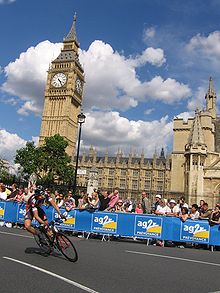
2007: The tour in front of the London landmark Big Ben
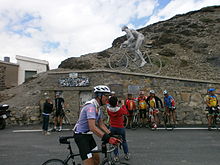
Géant du Tourmalet- Monument to the first crossing of the Col du Tourmalet in 1910
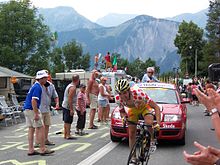
David de la Fuente climbs the Alpe d'Huez in 2006 in the polka-dot jersey

A typical mountain classification in the high mountains, here in 2007 on the Col de la Colombière
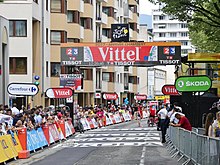
Finish line at the Tour 2017

The Col du Tourmalet is the most frequently passed pass of the Tour
.jpg)
The finish on the Champs-Élysées
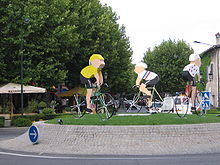
Typical design of a roundabout during the tour
Subscriber
Since 1969, the Tour de France has been contested by professional teams operated or sponsored by companies for advertising purposes, as was the case in the early days of the race. From 1930 to 1961 and then again in 1967 and 1968, however, national teams competed.
Some 21 to 22 professional teams are invited to the Tour de France each year, which until 2017 consisted of nine riders each, and for the first time in 2018 consisted of just eight. The 18 UCI WorldTeams have the right and obligation to participate according to the UCI regulations for WorldTour races. The organiser selects the remaining teams from among the Professional Continental Teams. Most of the teams usually come from France, Italy and Spain, plus individual teams from Belgium, the Netherlands, Germany, Denmark, Switzerland and the USA. These nations also provide the majority of the riders. Individual professional cyclists come from the rest of Central Europe, Scandinavia, Eastern Europe as well as Kazakhstan, Colombia, Australia, South Africa and Japan.
Since the 2018 edition, Frenchman Sylvain Chavanel is the sole record participant in the Tour de France with 18 starts, followed by Jens Voigt from Mecklenburg, US American George Hincapie and Australian Stuart O'Grady with 17 appearances each. However, they all did not always reach the finish in Paris.
On the other hand, Dutchman Joop Zoetemelk, who started 16 times, is the sole record holder for finishes, as he also finished the Tour after every start, including seven times on the podium and once as overall winner in 1980.
Lucien Van Impe, multiple winner of the mountain classification and overall winner in 1976, his Belgian compatriot Guy Nulens (best place: 22nd) and the Russian Vyacheslav Vladimirovich Yekimov each contested the Tour de France 15 times. The latter, like Zoetemelk, always reached Paris and thus ranks second in the finishes.
With 14 participations, Erik Zabel, six-time winner of the points classification, ranks second among the German record participants behind Jens Voigt.
Search within the encyclopedia